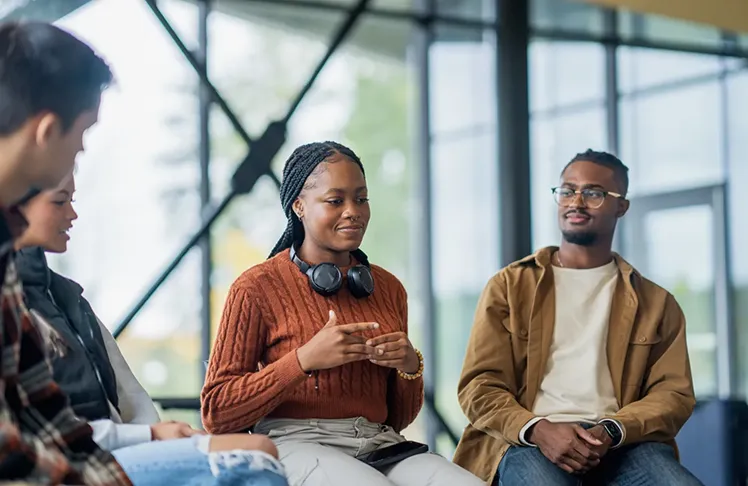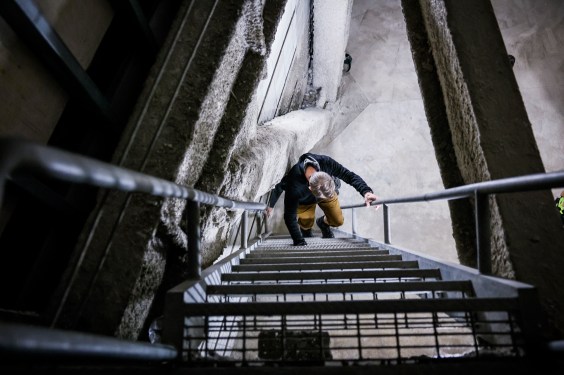

by Mekhi Abbott
The Brazilian educator and philosopher Paulo Freire once said that without conversation, there is no room for understanding. Yet for meaningful conversations to be had, people must be willing to show up and listen.
That’s the concept behind a program at the University of Maryland-Baltimore County that gathers people to talk openly and honestly across the racial divide. Sponsored by a philanthropic foundation and supported through a higher-education nonprofit, it’s billed as a low-cost, engaging way to facilitate mutual understanding and advance progress.
The program — healing circles, hosted at UMBC — aims to create inviting spaces that bring students, faculty, and members of the community together to talk about the different perspectives individuals have based on lived experiences. These lived experiences vary based off of bias, socioeconomic status, and cultural background, among other factors.
At the most recent healing circles, however, the number of staff and faculty members has outnumbered students. It’s a challenge that Emily Sugrue, the organizer of UMBC’s healing circles, takes seriously.
“I do see that as a problem. Our hope is to get students trained as facilitators of these circles so that they can encourage their fellow students to attend,” she says. “Another goal of ours is to get community participation. Circles serve as open forums and we don’t just want UMBC folks but as people from the wider community in the greater Baltimore area.”
One way to meet that goal, she says, is to “simply cast a wider net and see who shows up.”
The healing circles are evidence of UMBC’s participation in Truth, Racial Healing and Transformation Campus Centers, a network of facilitators and programs designed to help undo harmful stereotypes, rewrite damaging narratives, and train people to dismantle toxic racial hierarchies at the grassroots level.
Sponsored in part by the American Association of Colleges & Universities, Truth, Racial Healing and Transformation Campus Centers host a broad range of programs, workshops, and healing circles. UMBC has been a member of the network since 2017.
Nusrat Tusi, a social media and public relations intern at UMBC, says Sugrue’s monthly healing circles create an environment “where the goal is to recognize shared values, establish common ground, and inspire collective action, promoting healing from racism’s impacts.”
As the vice president of UMBC Sisterhood: Women of Color Coalition, Tusi’s experience and background became an asset when she participated in a TRHT event titled “Amplifying Student Voices.” The event, she says, was particularly timely.
“Student leaders on campuses across the U.S. came together to discuss how college campuses can still uphold diversity, equity, and inclusion after the Supreme Court’s decision to reverse affirmative action,” Tusi says. During the forum she says she met several students involved with the Shriver Center, a hub for community engagement and social change.
“We discussed to a great extent how much the center plays a role in campus social justice and belonging,” she says, “because of the various student service learning that happens for students to see outside of themselves and be more connected to the larger community, creating a larger sense of belonging.”
The Shriver Center aims to get students and faculty to participate in community engagement in order to foster an environment to dismantle racism.
Healing circles “provide safe spaces for students to connect on a personal level, share their experiences, and learn from one another,” Tusi says. “Student leadership forums [have] empowered students to find their voice and advocate for change.”
A Safe Space for Sharing Lived Experiences
Healing circles are an environment for students and staff to come together and learn from one another.
“We have had a number of circles so far this year,” Sugrue says. “It’s typically a group of six to 20 people who gather to talk about moments where they experienced a shift in the way they see the world — or see themselves — as it relates to some aspect of their identity. The idea is to uncover harmful narratives around race and around poverty.”
Sugrue’s objective was to dismantle preconceived notions about the racial divide, using community and conversation to unpack prejudiced notions and stereotypical assumptions.
“The biggest thing is getting participants to come to the realization that we have more in common than what separates us,” Sugrue says. “A good example is food stamps,” which is typically associated with people of color.
In reality, government food assistance “actually benefits more white people rather than people of color,” Sugrue says. The first step in racial healing, she adds, “is really just getting people to understand that when we fight amongst ourselves, we’re only hurting ourselves.”
To get younger and broader community involvement, Sugrue is working to get the word out, encouraging people with different interests, backgrounds, and knowledge bases to join in.
“One model is to simply cast a wider net and see who shows up,” she says.
By doing that, “we can hopefully build stronger relationships.”
Another goal is building strong coalitions that can tackle some of these issues in more direct and concrete ways. “We need to get beyond simple conversations and start moving in the direction of policy change,” Sugrue says.
My friend Sasha was banned for life from the Providence Place Mall when she was 20. She and her friends would sneak into movies at the mall’s theater through the maze of back hallways and tunnels. They climbed onto the mall’s roof. I imagine them like the subterranean ants in an ant farm: constantly scurrying, unseen and underfoot.
The only thing deterring people from entering these halls was social convention. We live in a society. We don’t walk through doors with signs that say “authorized personnel only.” That is, unless you’re a young person with a palpable disregard for authority and the social conventions upon which our society is built.


The day after Elon Musk suffered a beautifully humiliating political defeat, the news about his primary source of wealth is similar, and apparently Trump is beginning to understand that he’s a liability:
Deliveries of Elon Musk’s Tesla vehicles dropped about 13% compared to a year ago, according to a new release from the company. The decline comes amid criticism of Musk and increased competition.
On Wednesday, Tesla reported it produced over 362,000 vehicles and delivered over 336,000 in the first quarter of 2025. That performance marked a decline compared to the same period one year ago, when Tesla produced over 433,000 vehicles and delivered about 387,000.
Tesla stock fell nearly 3% in early trading on Wednesday following the news of the decline in deliveries. But the stock reversed those losses after reports that President Donald Trump told advisers that Musk may leave his White House role.
As of Wednesday afternoon, Tesla shares were up about 5%.
The company has faced fierce backlash — including violence and vandalism against its cars and dealerships– as Musk, the company’s CEO, works in Washington alongside Donald Trump to slash the federal government.
If I may be permitted to question the wisdom of the market that massively overvalued Tesla in the first place, even if Musk does actually leave his current job as CEO of the United States, I don’t think the damage with Tesla’s core customer base can be undone — the gutting of critical government functions has already been done, and will be using his social media site to remind people about his unpopular reactionary views while amplifying those of others. And certainly people involved in #TeslaTakedown shouldn’t back off:
Musk cannot take the heat. He has not just the taste and sensibilities of a boy, but the temperament of one. He throws a fit when things don’t go his way. He wilts. This is someone who can be beat. In another context you might call this terminal inability to take a punch a “glass jaw.” The term “keyboard warrior” comes to mind. But I can think of another word for something that’s so ostentatious and in-your-face except for when it needs to be—a symbol of decadence and insecurity and deregulation that boasts bulletproof toughness, but which breaks into pieces at the first sign of stress.
Elon’s not unstoppable, Wisconsin voters showed on Tuesday. When the rubber hits the road, he’s nothing but a Cybertruck.
And in Wisconsin, they suffered a crushing defeat in a record-breakingly expensive Supreme Court race. After Musk’s money and personality dominated the contest, liberal Judge Susan Crawford secured a 9-point victory against Trump’s endorsed candidate, Brad Schimel.
“I’m honestly shocked. I thought we had it in the bag,” said Pam Van Handel, chair of the Republican Party of Wisconsin’s Outagamie County. “I thought [Musk] was going to be an asset for this race. People love Trump, but maybe they don’t love everybody he supports. Maybe I have blinders on.”
Maybe!
The post Rapid unscheduled disassembly appeared first on Lawyers, Guns & Money.
